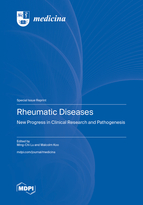Rheumatic Diseases: New Progress in Clinical Research and Pathogenesis
A special issue of Medicina (ISSN 1648-9144). This special issue belongs to the section "Hematology and Immunology".
Deadline for manuscript submissions: closed (10 April 2023) | Viewed by 24612
Special Issue Editors
Interests: rheumatoid arthritis; T cells; non-coding RNAs; systemic lupus erythematosus
2. Dalla Lana School of Public Health, University of Toronto, Toronto, ON M5T 3M7, Canada
Interests: bibilometrics; epidemiology; health survey; complementary medicine
Special Issues, Collections and Topics in MDPI journals
Special Issue Information
Dear Colleagues,
Rheumatic diseases are a diverse group of autoimmune disorders that primarily affect the joints, bones, muscles, and connective tissues. Rheumatic diseases, such as rheumatoid arthritis, systemic lupus erythematosus, Sjögren's syndrome, and ankylosing spondylitis, are chronic diseases that cause a dysregulation of the immune system. Different types of rheumatic diseases are associated with a wide array of clinical manifestations and complex pathogeneses.
The purpose of this Special Issue is to encourage researchers to share their latest research and to summarize the recent advances in clinical and pathologic aspects of the rheumatic disease. We invite authors to submit original articles and review articles focusing on pertinent topics and new advances in rheumatic diseases.
Prof. Dr. Ming-Chi Lu
Dr. Malcolm Koo
Guest Editors
Manuscript Submission Information
Manuscripts should be submitted online at www.mdpi.com by registering and logging in to this website. Once you are registered, click here to go to the submission form. Manuscripts can be submitted until the deadline. All submissions that pass pre-check are peer-reviewed. Accepted papers will be published continuously in the journal (as soon as accepted) and will be listed together on the special issue website. Research articles, review articles as well as short communications are invited. For planned papers, a title and short abstract (about 100 words) can be sent to the Editorial Office for announcement on this website.
Submitted manuscripts should not have been published previously, nor be under consideration for publication elsewhere (except conference proceedings papers). All manuscripts are thoroughly refereed through a single-blind peer-review process. A guide for authors and other relevant information for submission of manuscripts is available on the Instructions for Authors page. Medicina is an international peer-reviewed open access monthly journal published by MDPI.
Please visit the Instructions for Authors page before submitting a manuscript. The Article Processing Charge (APC) for publication in this open access journal is 1800 CHF (Swiss Francs). Submitted papers should be well formatted and use good English. Authors may use MDPI's English editing service prior to publication or during author revisions.
Keywords
- rheumatoid arthritis
- systemic lupus erythematosus
- Sjögren's syndrome
- ankylosing spondylitis
- rheumatic diseases








